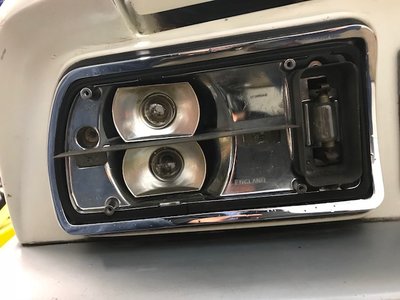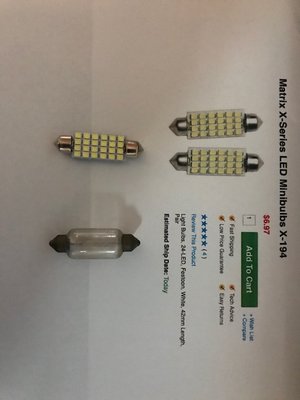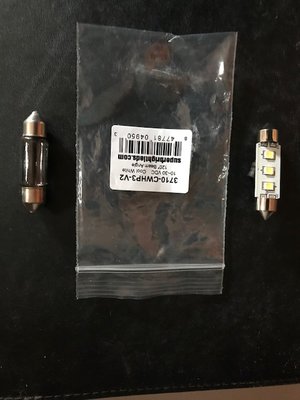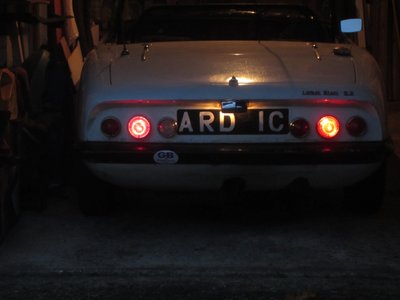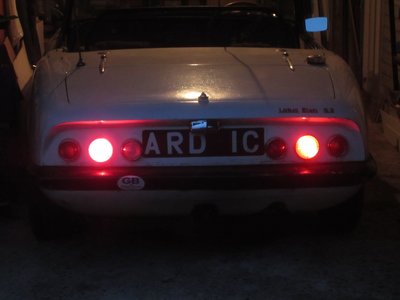The LED lighting thread
65 posts
• Page 2 of 5 • 1, 2, 3, 4, 5
Craven wrote:IIRC there may some issues with regards twin filament LED?s and the UK MOT, these clever LED lamp makers produce a single array of 21w and tap off to give the 5w. OK but that means in practice Max output being 21w, applying the brake at night only increases the output by 16w. It will be interesting to see if Alan?s appraisal includes this observation.
FWIW
Ron.
Ron,
I think that's a very good point and I will be sure to do the test in a dark garage with tail lights on before applying the brakes. I will probably get Mrs T to dab the brakes while I do photo's leaving one side standard for comparison. The cost of the bulbs is only ?9.95 inc postage for the pair, if they are an improvement then that's great, if not then there's not a lot of money wasted and I always have the 14 day rule to return them if I think they are totally not fit for purpose.
Kindest regards
Alan Thomas
Alan Thomas
-

Spyder fan - Coveted Fifth Gear

- Posts: 2019
- Joined: 11 Jun 2009
Its time the lighting r?gulations came into the 21st century and rated bulbs by luminous intensity/candlepower instead of watts, 21 watts of LED light is a whole lot brighter than incandescent, great for safety regarding brake lights but there is a risk of dazzling following vehicles for rear lights, existing rear fog lights when misused are a real hazard.
130 watts of led light facing forward would be blinding and the light output per watt just keeps increasing.
As an aside regarding home LED spotlights which may be relevant to the made to the lowest cost car bulbs, I have 7 watt (7 * 1 watt led) spotlights across all my rental properties, a couple of hundred fittings, to date the daylight ones have been reliable except a couple of transformer failures but after a few years am probably approaching 100% failure of the warm white ones dependant on how long they have been running, at first I could not see how to get them apart and dint think they could be repairable so was throwing them out as I had plenty of spares.
Then when they kept failing I found that I could get them apart and indeed repair them, they are in fact just 7 LEDs in a series circuit with no other components, one fails (usually a heat sink problem) and the remaining 6 go out, this could have serious implications for the multi-led car bulbs if they also are a series circuit, the more leds per bulb the greater the odds of failure.
In my case one failed spotlight yields enough leds to repair 6 others, testing is dead easy, just shunt out each led in turn, when you get to the failed one the others all light up.
130 watts of led light facing forward would be blinding and the light output per watt just keeps increasing.
As an aside regarding home LED spotlights which may be relevant to the made to the lowest cost car bulbs, I have 7 watt (7 * 1 watt led) spotlights across all my rental properties, a couple of hundred fittings, to date the daylight ones have been reliable except a couple of transformer failures but after a few years am probably approaching 100% failure of the warm white ones dependant on how long they have been running, at first I could not see how to get them apart and dint think they could be repairable so was throwing them out as I had plenty of spares.
Then when they kept failing I found that I could get them apart and indeed repair them, they are in fact just 7 LEDs in a series circuit with no other components, one fails (usually a heat sink problem) and the remaining 6 go out, this could have serious implications for the multi-led car bulbs if they also are a series circuit, the more leds per bulb the greater the odds of failure.
In my case one failed spotlight yields enough leds to repair 6 others, testing is dead easy, just shunt out each led in turn, when you get to the failed one the others all light up.
- Chancer
- Coveted Fifth Gear

- Posts: 1133
- Joined: 20 Mar 2012
Chancer wrote:Then when they kept failing I found that I could get them apart and indeed repair them, they are in fact just 7 LEDs in a series circuit with no other components, one fails (usually a heat sink problem) and the remaining 6 go out, this could have serious implications for the multi-led car bulbs if they also are a series circuit, the more leds per bulb the greater the odds of failure.
That is a good point. With most LEDs being 2-3v on the 12v car it is highly unlikely that a single failure would take the full light out. As with the LED count there must be a number of parallel circuits with multiple LED in serial on the bulb, rather than a single serial circuit.
However failure of one of two LED might lower the brightness output to a concerning level without being obvious from a quick light check.
'73 +2 130/5 RHD, now on the road and very slowly rolling though a "restoration"
- mbell
- Coveted Fifth Gear

- Posts: 2643
- Joined: 07 Jun 2013
mbell wrote:Chancer wrote:However failure of one of two LED might lower the brightness output to a concerning level without being obvious from a quick light check.
Few people notice the lower output of their lamps when they have the classic earth fault in their dual filament lamps, until they notice the whole unit goes out if tail and stop lamps are both active. How many people know their lights are working at all?
Refering to an earlier part of this thread, the difference between 21+5W vs 21W is small, less than 1 dB in a change of 7 dB between tail and stop power, and can be ignored. The eye is logarithmic like the ear otherwise we wouldn't cope with the brightness range we experience.
Meg
26/4088 1965 S1½ Old and scruffy but in perfect working order; the car too.
________________Put your money where your mouse is, click on "Support LotusElan.net" below.
26/4088 1965 S1½ Old and scruffy but in perfect working order; the car too.
________________Put your money where your mouse is, click on "Support LotusElan.net" below.
-

Quart Meg Miles - Coveted Fifth Gear

- Posts: 1170
- Joined: 03 Oct 2012
meg
I find your comments interesting, what is your 0 db reference. Are you commenting on the eye performance in daylight or the practical situation of night vision?
Alan, a further point in your appraisal, apparently if you are still using normal turn indicators 21w bulbs the stop/brake light will vary in intensity in sync with flasher!!
Ron.
I find your comments interesting, what is your 0 db reference. Are you commenting on the eye performance in daylight or the practical situation of night vision?
Alan, a further point in your appraisal, apparently if you are still using normal turn indicators 21w bulbs the stop/brake light will vary in intensity in sync with flasher!!
Ron.
- Craven
- Coveted Fifth Gear

- Posts: 1622
- Joined: 14 Sep 2013
All very interesting.
I had been warned previously that the flasher unit or circuit would need to be altered due to much lower current drain of the LED bulbs, so I was ignoring these for the time being. At the moment I'm more interested in visibility on the road at night and having brighter stop lights day and night. Slightly brighter side lights would be good as well, so that I can use them as daytime running lights.
I have added a "check the indicators don't make the stop lights vary in intensity" to the appraisal list.
I had been warned previously that the flasher unit or circuit would need to be altered due to much lower current drain of the LED bulbs, so I was ignoring these for the time being. At the moment I'm more interested in visibility on the road at night and having brighter stop lights day and night. Slightly brighter side lights would be good as well, so that I can use them as daytime running lights.
I have added a "check the indicators don't make the stop lights vary in intensity" to the appraisal list.
Kindest regards
Alan Thomas
Alan Thomas
-

Spyder fan - Coveted Fifth Gear

- Posts: 2019
- Joined: 11 Jun 2009
Craven wrote:meg
I find your comments interesting, what is your 0 db reference. Are you commenting on the eye performance in daylight or the practical situation of night vision?
Alan, a further point in your appraisal, apparently if you are still using normal turn indicators 21w bulbs the stop/brake light will vary in intensity in sync with flasher!!
Ron.
Ron,
I was meaning the performance at night time when applying brakes with sidelamps already on, the 0 dB reference point. So with filaments the Stop lamp is a 7 dB step but with the LEDs, as described earlier, 6 dB. In the absence of direct comparison it wouldn't be noticed and present car lamps vary considerably more than that between makes.
While stacked LEDs will be pretty sensitive to voltage changes, assuming they don't use proper regulation, any significant brightness change due to other proper bulbs flashing still indicates poor earthing or shared power wiring.
I'm biased against LED signal lamps on cars, their unnaturally immediate appearance/disappearance seems too confuse my eyes and make the signals less visible, especially in lamp clusters; does anyone else experience this?
Meg
26/4088 1965 S1½ Old and scruffy but in perfect working order; the car too.
________________Put your money where your mouse is, click on "Support LotusElan.net" below.
26/4088 1965 S1½ Old and scruffy but in perfect working order; the car too.
________________Put your money where your mouse is, click on "Support LotusElan.net" below.
-

Quart Meg Miles - Coveted Fifth Gear

- Posts: 1170
- Joined: 03 Oct 2012
Meg,
Alan?s practical feedback will be interesting, the phenomenon of sympathetic pulsing of stop/brake light with turn indicator is fairly well known. Several explanations have been put forward on other forums, most common being the LED?s fast response time causing their output to follow any pulses in the supply not normally seen by the slower filament bulb. Poor earth return was my first thoughts when trying to fix this but not so, even doubling up on common supply lines did not completely stop the effect.
Ron.
Alan?s practical feedback will be interesting, the phenomenon of sympathetic pulsing of stop/brake light with turn indicator is fairly well known. Several explanations have been put forward on other forums, most common being the LED?s fast response time causing their output to follow any pulses in the supply not normally seen by the slower filament bulb. Poor earth return was my first thoughts when trying to fix this but not so, even doubling up on common supply lines did not completely stop the effect.
Ron.
- Craven
- Coveted Fifth Gear

- Posts: 1622
- Joined: 14 Sep 2013
I'm biased against LED signal lamps on cars, their unnaturally immediate appearance/disappearance seems too confuse my eyes and make the signals less visible, especially in lamp clusters; does anyone else experience this?
Something similar, here in France traffic lights have little repeater lights lower down the pole at driver level so you dont have to crane your neck and look up, they are all LED's of course now, on one junction only when I pull up, if I am looking forward and the red light is in my peripheral and not the macular vision it flashes, if I turn my head or swivel my eye (singular as my left one is effectively blind) its no longer flashing, this only occurs when I am driving my RHD ex UK car, if I drive a LHD car the angles are different but it should be even further to my peripheral vision, I have never worked it out and no-one else can see the flashing.
I can also see the blue light from a UV lamp be it a bank note tester and supposedly invisible IR beacons on aircraft or CCTV IR floodlights but I know the reason for that, the flickering red LED remains a mystery yet to be solved.
Something similar, here in France traffic lights have little repeater lights lower down the pole at driver level so you dont have to crane your neck and look up, they are all LED's of course now, on one junction only when I pull up, if I am looking forward and the red light is in my peripheral and not the macular vision it flashes, if I turn my head or swivel my eye (singular as my left one is effectively blind) its no longer flashing, this only occurs when I am driving my RHD ex UK car, if I drive a LHD car the angles are different but it should be even further to my peripheral vision, I have never worked it out and no-one else can see the flashing.
I can also see the blue light from a UV lamp be it a bank note tester and supposedly invisible IR beacons on aircraft or CCTV IR floodlights but I know the reason for that, the flickering red LED remains a mystery yet to be solved.
- Chancer
- Coveted Fifth Gear

- Posts: 1133
- Joined: 20 Mar 2012
might be a question to put to your Opthalmic consultant at your next appointment. I've had a few thousand laser shots in my eyes and it's weird what that does in the very short term but in the longer term I still see flares from streetlights at night. I know they aren't there but still I see them - Weird!
Some great input here please keep it up. Be good if someone could populate the bob holder sizes.
Once we get some proven good quality led units perhaps we can approach a manufacturer to make up a conversion kit which would make life a lot easier.
Some great input here please keep it up. Be good if someone could populate the bob holder sizes.
Once we get some proven good quality led units perhaps we can approach a manufacturer to make up a conversion kit which would make life a lot easier.
Steve
Silence is Golden; Duct Tape is Silver
Silence is Golden; Duct Tape is Silver
-

elanfan1 - Coveted Fifth Gear

- Posts: 1720
- Joined: 13 Jan 2004
I earlier posted about using LED compatible flasher relays. A member indicated that he was still confused about what flashers and LED's might be used. Rather than start a new thread I have added my recent experience with LED's here. Some of this is perhaps a repeat but collecting it in one post might be helpful.
In sum, the LED's are a vast improvement and quite easy to install. One does need to change the flasher relays as shown below (which will work with the incandescent lights as well).
I have indicated where I sourced the parts, but this is not an endorsement or advert, just to indicate part numbers.
Undoubtedly similar units can readily be sourced elsewhere.
Comments pertain to a 1969 Federal S4, so various lights will be different on different models, but the same basic units seem to be used throughout.
Original bulbs in place:
Shows reflectors and dividing plate.
Rear/brake lights: These are a dual filament BA 15D base, 21/5W. Replaced by a red dual circuit LED as shown:
Rear indicators: These are a single filament BA 15S base, 21W. Replaced by an amber LED as shown:
(Source: SuperBrightLeds)
Rear back up lights: These are a "festoon" light as shown. These are directional so if do not work turn them around. The LED replacement makes a massive difference. (Source: Summit Racing(
Rear number plates: These are a smaller festoon light as shown. Again the LED replacement makes a large difference. These are directional, so if do not work turn around. (Source: SuperBrightLeds)
Front indicators: These are dual filament BA 15D. Replaced by a dual circuit amber LED. Same as rear light/brake but amber.
Front side lights: These are blanked out on the 69 Federal S4 but I will be installing these as daylight running lights similar to posted earlier by others. In my case the DRL's will follow the legal convention (at least in California) of being automatically
a. shut-off during turn signaling and
b. converted from white to amber when the headlights are on. (Separate post to follow on this implementation).
Concerning LED compatible flashers. The existing Niles (tall can) and Tridon (smaller plastic) were both replaced by the CEC unit shown. The new CEC unit does require a ground wire but otherwise directly replaces the existing units. There is no need to place resistors in series with the LED's to increase loads to make the flashers work. (Source: Amazon)
(Side note: I think this (the Niles flasher) is the only Asian part (Japanese) part that I have encountered on my original Elan. I am not aware of any other part being of Asian origin originally. This Niles unit was apparently used on a variety of other UK cars of the period.)
Note: I also tried Cool White LED's for both the rear/brake and indicators instead of the respective red and amber ones. The Cool White LED's when viewed through the plastic lens shifted the light toward orange (for the red) and yellow (for the amber). The colored LED's gave a much more uniform and pure color light with no apparent loss of brightness.
PS: apologies for the orientation of the pictures, hopefully still readable
In sum, the LED's are a vast improvement and quite easy to install. One does need to change the flasher relays as shown below (which will work with the incandescent lights as well).
I have indicated where I sourced the parts, but this is not an endorsement or advert, just to indicate part numbers.
Undoubtedly similar units can readily be sourced elsewhere.
Comments pertain to a 1969 Federal S4, so various lights will be different on different models, but the same basic units seem to be used throughout.
Original bulbs in place:
Shows reflectors and dividing plate.
Rear/brake lights: These are a dual filament BA 15D base, 21/5W. Replaced by a red dual circuit LED as shown:
Rear indicators: These are a single filament BA 15S base, 21W. Replaced by an amber LED as shown:
(Source: SuperBrightLeds)
Rear back up lights: These are a "festoon" light as shown. These are directional so if do not work turn them around. The LED replacement makes a massive difference. (Source: Summit Racing(
Rear number plates: These are a smaller festoon light as shown. Again the LED replacement makes a large difference. These are directional, so if do not work turn around. (Source: SuperBrightLeds)
Front indicators: These are dual filament BA 15D. Replaced by a dual circuit amber LED. Same as rear light/brake but amber.
Front side lights: These are blanked out on the 69 Federal S4 but I will be installing these as daylight running lights similar to posted earlier by others. In my case the DRL's will follow the legal convention (at least in California) of being automatically
a. shut-off during turn signaling and
b. converted from white to amber when the headlights are on. (Separate post to follow on this implementation).
Concerning LED compatible flashers. The existing Niles (tall can) and Tridon (smaller plastic) were both replaced by the CEC unit shown. The new CEC unit does require a ground wire but otherwise directly replaces the existing units. There is no need to place resistors in series with the LED's to increase loads to make the flashers work. (Source: Amazon)
(Side note: I think this (the Niles flasher) is the only Asian part (Japanese) part that I have encountered on my original Elan. I am not aware of any other part being of Asian origin originally. This Niles unit was apparently used on a variety of other UK cars of the period.)
Note: I also tried Cool White LED's for both the rear/brake and indicators instead of the respective red and amber ones. The Cool White LED's when viewed through the plastic lens shifted the light toward orange (for the red) and yellow (for the amber). The colored LED's gave a much more uniform and pure color light with no apparent loss of brightness.
PS: apologies for the orientation of the pictures, hopefully still readable
'69 Elan S4 SE
Street 181 BHP
Original owner
Street 181 BHP
Original owner
- 1owner69Elan
- Fourth Gear

- Posts: 846
- Joined: 16 Jun 2015
Good post, but I guess these 33RL units are Neg earth only and the drivers will only supply positive currents. My early car is still Pos earth but the outputs could be inverted with a couple of Vmos transistors.
The sidelamp LED at the start of the thread draws 1.5 Watts at 14.7V compared to the nominal 6 Watts incandescent bulb but is so much brighter. But their angle of view is limited to 45? which may not be legal; the standard bulb in the front lamp can be seen from side on.
----------------------------------------
In May Chancer wrote:
I'm biased against LED signal lamps on cars, their unnaturally immediate appearance/disappearance seems to confuse my eyes and make the signals less visible, especially in lamp clusters; does anyone else experience this?
---------------------------------------
Yes, exactly as described! I think the modern trick of extinguishing other fixed lights on the same corner as a flasher is to solve that effect though I'm not sure if they do it on the back which may or may not have a brake lamp on too.
The sidelamp LED at the start of the thread draws 1.5 Watts at 14.7V compared to the nominal 6 Watts incandescent bulb but is so much brighter. But their angle of view is limited to 45? which may not be legal; the standard bulb in the front lamp can be seen from side on.
----------------------------------------
In May Chancer wrote:
I'm biased against LED signal lamps on cars, their unnaturally immediate appearance/disappearance seems to confuse my eyes and make the signals less visible, especially in lamp clusters; does anyone else experience this?
---------------------------------------
Yes, exactly as described! I think the modern trick of extinguishing other fixed lights on the same corner as a flasher is to solve that effect though I'm not sure if they do it on the back which may or may not have a brake lamp on too.
Meg
26/4088 1965 S1½ Old and scruffy but in perfect working order; the car too.
________________Put your money where your mouse is, click on "Support LotusElan.net" below.
26/4088 1965 S1½ Old and scruffy but in perfect working order; the car too.
________________Put your money where your mouse is, click on "Support LotusElan.net" below.
-

Quart Meg Miles - Coveted Fifth Gear

- Posts: 1170
- Joined: 03 Oct 2012
Here's a positive earth flasher that appears to be suitable:
https://www.ebay.co.uk/itm/12V-ELECTRON ... 1922801187
As I mentioned my car did not come with sidelights, just a blank spot on the body. Putting an LED as a daylight running light (DRL) seems to be a reasonable addition in my case. There is no legal issue per se, so long as I shut the DRL off while signaling, as I intend to do.
Regarding the visibility of indicators, I found the following:
1. On the back lights (again Federal S4) the amber indicator lights are off until lit for a turn signal. Thus, there is a very clear demarcation on/off. Also, the red upper part is separated by a metal baffle so there is no scatter.
2. On the front indicators, a different situation. The dual circuit amber (BA 15D) incandescent gives a pretty clear demarcation between on/flashed. But the LED is more subtle, wherein the flashed indicator is only slightly brighter at least to the eye. Interestingly, the red rear lights that are also dual circuit seem fine. When the brakes are applied the difference in intensity is quite clear. But of course the brake lights are not flashed.
In fact, I am not that happy with the LED's compared to the incandescent for the front indicators even though they are brighter in static mode. When flashing indicating a turn, they definitely are not as distinct. As a result, I may likely go back to the incandescents for the front indicators. Fortunately, the flasher relays work for both types of bulb.
https://www.ebay.co.uk/itm/12V-ELECTRON ... 1922801187
As I mentioned my car did not come with sidelights, just a blank spot on the body. Putting an LED as a daylight running light (DRL) seems to be a reasonable addition in my case. There is no legal issue per se, so long as I shut the DRL off while signaling, as I intend to do.
Regarding the visibility of indicators, I found the following:
1. On the back lights (again Federal S4) the amber indicator lights are off until lit for a turn signal. Thus, there is a very clear demarcation on/off. Also, the red upper part is separated by a metal baffle so there is no scatter.
2. On the front indicators, a different situation. The dual circuit amber (BA 15D) incandescent gives a pretty clear demarcation between on/flashed. But the LED is more subtle, wherein the flashed indicator is only slightly brighter at least to the eye. Interestingly, the red rear lights that are also dual circuit seem fine. When the brakes are applied the difference in intensity is quite clear. But of course the brake lights are not flashed.
In fact, I am not that happy with the LED's compared to the incandescent for the front indicators even though they are brighter in static mode. When flashing indicating a turn, they definitely are not as distinct. As a result, I may likely go back to the incandescents for the front indicators. Fortunately, the flasher relays work for both types of bulb.
'69 Elan S4 SE
Street 181 BHP
Original owner
Street 181 BHP
Original owner
- 1owner69Elan
- Fourth Gear

- Posts: 846
- Joined: 16 Jun 2015
I bit the bullet and bought (Classic Car LEDs, eBay) a pair of Pos earth dual-filament LED bulbs.
The LED tail (sidelamp) element drew 0.075 Amps at 13.5V against the filament's 0.44 Amps (17%);
The LED brake element drew 0.15 Amps at 13.5V against the filament's 1.8 Amps (9%);
The LED tail lamp was similar in brightness to the filament and the LED brake lamp was noticably less bright with little difference with angle of view. I am disappointed as I was hoping for a considerable increase in the tail lamp brightness. The pictures below show a filament bulb on the LH side and a LED on the RH.
The LED tail (sidelamp) element drew 0.075 Amps at 13.5V against the filament's 0.44 Amps (17%);
The LED brake element drew 0.15 Amps at 13.5V against the filament's 1.8 Amps (9%);
The LED tail lamp was similar in brightness to the filament and the LED brake lamp was noticably less bright with little difference with angle of view. I am disappointed as I was hoping for a considerable increase in the tail lamp brightness. The pictures below show a filament bulb on the LH side and a LED on the RH.
Meg
26/4088 1965 S1½ Old and scruffy but in perfect working order; the car too.
________________Put your money where your mouse is, click on "Support LotusElan.net" below.
26/4088 1965 S1½ Old and scruffy but in perfect working order; the car too.
________________Put your money where your mouse is, click on "Support LotusElan.net" below.
-

Quart Meg Miles - Coveted Fifth Gear

- Posts: 1170
- Joined: 03 Oct 2012
65 posts
• Page 2 of 5 • 1, 2, 3, 4, 5
Total Online:
Users browsing this forum: No registered users and 9 guests

